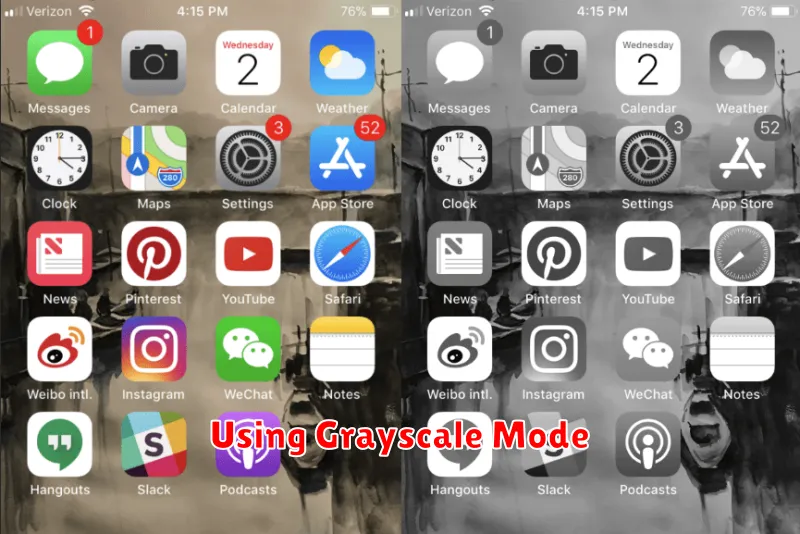In today’s hyper-connected world, smartphone addiction has become a pervasive issue, impacting individuals of all ages. Excessive phone use can lead to a myriad of negative consequences, affecting our mental health, productivity, and overall well-being. This article explores practical and effective tips for reducing smartphone addiction and regaining control over your digital life. Learning how to manage your screen time effectively can lead to improved focus, healthier relationships, and a more fulfilling life. If you’re struggling with excessive smartphone use, you’re not alone. We’ll equip you with the strategies you need to break free from the grip of phone addiction and cultivate a more balanced relationship with technology.
Are you constantly checking your phone, even when there are no notifications? Do you feel anxious when you’re separated from your device? These could be signs of smartphone addiction. This article provides actionable tips designed to help you curb your phone dependence and foster healthier digital habits. Discover how to minimize distractions, establish healthy boundaries with your smartphone, and reclaim your time and attention. We’ll cover techniques for managing notifications, creating tech-free zones, and prioritizing real-world interactions over constant connectivity. Take the first step towards a healthier relationship with your smartphone and experience the benefits of a more balanced and fulfilling life.
Recognizing Signs of Addiction
Acknowledging a potential smartphone addiction is the first step towards recovery. Several key indicators can help you determine if your smartphone use has become problematic. Look for these warning signs:
Increased Usage: Are you spending significantly more time on your phone than intended? Do you find yourself constantly checking your phone even when there are no notifications?
Withdrawal Symptoms: Do you feel anxious, irritable, or restless when you’re away from your phone? Do you experience a strong urge to check your phone even when it’s inappropriate?
Neglecting Responsibilities: Are you neglecting work, school, or personal responsibilities because of your phone use? Is your phone use impacting your relationships with family and friends?
Failed Attempts to Control Use: Have you tried to reduce your phone use but failed? Do you find yourself using your phone more than you intended, even after setting limits?
Setting Usage Limits
One effective method for curbing excessive smartphone use is to establish clear usage limits. Most modern smartphones offer built-in tools to monitor and restrict app usage. Actively configuring these settings is a crucial first step.
Set daily or weekly limits for specific apps, particularly those known to consume significant amounts of your time. Consider setting limits for overall phone usage as well. When the allotted time is reached, the phone will provide a notification, reminding you to take a break.
Downtime scheduling is another beneficial feature. Configure your device to limit access to certain apps or functionalities during specific periods, like work hours or bedtime. This promotes focused activity and ensures restful sleep.
Creating Phone-Free Zones

Establishing phone-free zones is a practical strategy for managing smartphone use and reclaiming control over your attention. These designated areas serve as sanctuaries from digital distractions, promoting mindfulness and real-world engagement.
Consider implementing phone-free zones in areas where focus and connection are paramount, such as the bedroom, dining room, or bathroom. This allows you to fully engage in activities like sleep, conversation, and personal care without the constant pull of notifications.
You can also designate specific times as phone-free periods, such as the first hour after waking up or the last hour before bed. This helps establish healthy boundaries and fosters a sense of digital detachment.
Using App Timers
App timers are a powerful tool for curbing excessive smartphone use. Most modern operating systems offer built-in functionality to set daily usage limits for individual apps. Once the allotted time is reached, the app is blocked, or a notification reminds you to take a break.
Start by identifying your most used apps. Consider using the built-in screen time tracking features of your device to gather this data. Then, set realistic time limits for each app. Gradually reduce these limits over time to regain control over your usage habits.
Turning Off Notifications
One of the most effective ways to regain control over your smartphone usage is to disable non-essential notifications. Constant buzzing and alerts from social media, games, and other apps train your brain to crave immediate gratification and can significantly disrupt your focus.
Start by identifying which notifications are truly necessary. Consider keeping only those related to essential communication such as calls, direct messages, or calendar reminders. Silence all other app notifications to create a quieter digital environment. This will allow you to engage with your phone on your own terms, rather than being constantly interrupted.
Establishing Daily Routines
A structured daily routine can be a powerful tool in managing smartphone usage. By incorporating designated times for checking your phone, you regain control and minimize mindless scrolling.
Start by scheduling specific times for checking emails and social media. Outside these windows, resist the urge to pick up your device. This conscious effort helps establish healthy boundaries and reduces the likelihood of getting sucked into the digital vortex.
Fill the time you would normally spend on your phone with alternative activities. Consider exercising, reading, pursuing a hobby, or spending time with loved ones. These activities not only provide a welcome distraction but also contribute to a more balanced and fulfilling lifestyle.
Finding Alternative Activities
A crucial step in reducing smartphone dependence is discovering engaging offline activities. Replacing screen time with real-world experiences can significantly diminish the urge to constantly check your phone.
Consider activities that foster creativity, promote physical activity, or encourage social interaction. Hobbies such as painting, playing a musical instrument, or gardening can provide a sense of accomplishment and mental stimulation. Physical activities like hiking, swimming, or team sports offer physical and mental health benefits while minimizing phone use. Social interactions, including spending time with loved ones, volunteering, or joining clubs, strengthen relationships and provide a sense of belonging.
By actively pursuing these alternative activities, you can create a more fulfilling and balanced lifestyle less reliant on constant smartphone stimulation.
Using Grayscale Mode

One effective technique for curbing smartphone overuse is enabling grayscale mode. This feature removes all color from your screen, rendering everything in shades of gray.
The rationale behind this approach is simple: color stimulates visual interest and engagement. By eliminating color, you reduce the visual appeal of apps and notifications, making them less enticing. This can help break the cycle of constantly checking your phone for visually stimulating content.
Many smartphones offer a built-in grayscale setting within their accessibility or display options. Activating this feature can significantly impact your usage habits by making your phone less stimulating and therefore less likely to distract you.
Social Support and Accountability
Enlisting social support is a powerful strategy for combating smartphone addiction. Share your goals with friends and family, asking them to hold you accountable.
Consider creating a shared system where you track your progress and receive encouragement from loved ones. This external motivation can make a significant difference in maintaining healthy digital habits.
Additionally, consider joining a support group or finding an accountability partner who is also striving to reduce smartphone use. Sharing experiences and challenges can provide valuable support and motivation.
Tracking Progress Over Time
Monitoring your smartphone usage is crucial for breaking free from addiction. Regularly tracking your progress helps you visualize how far you’ve come and stay motivated to continue reducing your screen time.
Utilize built-in phone features or dedicated apps to monitor your daily or weekly usage. Pay attention to which apps consume the most time and identify potential triggers for excessive use.
Consider creating a simple log or spreadsheet to record your screen time data. This allows you to analyze trends and pinpoint specific areas where you can improve. Celebrate small victories to reinforce positive behavior and maintain momentum.

